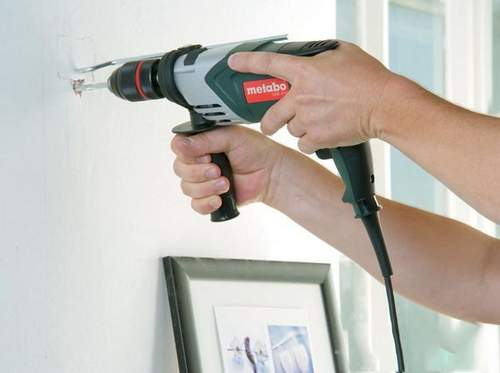05/17/2014 09:33
Quite often during repair work we have to drill a solid concrete base. be it holes for a suspended shelf, place for outlet or work on installing a new ceiling. And the task is quite difficult, as it might seem at first glance. over, concrete is a very heterogeneous composition and extremely dense material.
Let’s figure out how to properly and better than drilling concrete at home.
How to drill a concrete wall?
1. Conventional concrete drills are not suitable. It is better to use carbide drills, for example, drill bits. Such concrete drills have special brazed inserts made of carbide material at the ends (mainly a mixture of tungsten carbide and cobalt in a proportion of 10 to 90%). Carbide tips are easily recognizable. they have the form of a kind of "house".

2. If the holes are planned a little and they are relatively narrow, then at home you can use a drill with
shock function. An impact drill at home is suitable for holes in concrete with a diameter of not more than 12-13 mm, otherwise it is better to take a more expensive punch. As for a conventional drill (“shockless”), it is advisable to use it for concrete only as a last resort, if you do not have other working tools at hand.
3. The hammer drill is suitable for any concrete drilling. it is more effective due to its “crushing” function, although more expensive than an impact drill. In a rotary hammer, the rotation of the drill is combined with its reciprocating motion, which makes drilling work much faster. The punch is good when a lot of work is foreseen for drilling (for example, when you need to fix the crate to the ceiling or walls). Consider a punch. more powerful than a drill. Therefore, for example, it is not suitable for foam concrete (cellular concrete), since it will completely “ruin” the wall. And when drilling a perforator with ordinary concrete, do not overdo it. make sure that plaster does not spill.
4. For the punch, special drills (“SDS Plus” and “SDS-Max”) of various diameters are used. from 4-5 mm to 7-8 cm. In order not to buy a very expensive full set of drills, you need to choose drills for the punch by diameter future dowels, and just in case, a “plus or minus” a couple of neighboring ones in size.
Video: How to Drill Concrete with a Puncher
5. In addition to drilling with an impact drill and hammer drill, there is another way. the so-called diamond drilling. Only this option requires special drilling rigs and diamond drills. This type of concrete drilling is very expensive, and, as a rule, a team of repair technicians is hired for it. Diamond drilling is used when there is a lot of repair work planned for drilling a concrete base, or large holes or longitudinal grooves are needed (for example, when laying communications in a wall or floor). The advantage of this method. after the drilling rig there is no dust left. it delivers water to the hole, washing off the dust and cooling the drill.
Concrete drilling stages
1. Before starting work, be sure to think about whether there are any communications, cable, etc. in this place so as not to damage anything.
2. Next, check that there are no old spots and dirt at the drilling site, otherwise clean the surface well.
3. The outer part of the concrete is usually looser than the inner layers. Therefore, before you start drilling concrete, be sure to mark and expand the point of the future hole, that is, deepen (tilt) the base of the inlet of the drill in this place. This is done so that the drill does not slip and does not move to the side. For the core, you can use a hammer and a large sharp nail, a self-tapping screw or a special dowel.
4. During the work, hold the working tool perpendicular to the concrete base, otherwise the risks of the drill breaking will increase.
5. If you drill a hole with an impact drill, switch modes from time to time. In order to “beat” the surface, turn on the “hit” option in drills.
6. Like a drill, like a drill (perforator) you need to give "rest" from time to time. about once every 10-15 minutes. pause work.
7. Another such point. the same drill bits do not like overheating, therefore, with a strong operating load, their tips must be periodically cooled with water.
8. For concrete work, you will also need a trihedral solid steel punch and an ordinary hammer. suddenly crushed stone will meet in concrete. By the way, the old victorious drill is also suitable as a punch. If reinforcement or stones (gravel) are encountered during drilling, they are removed separately. The fittings can be processed with conventional tools (punch and a traditional drill for metal), but the stones lend themselves well only to the punch.
9. Suddenly you need to urgently make a couple of holes for the shelf, and only a regular drill (without impact mode) at hand, then during the drilling process you can periodically insert the punch into the hole and make a few hammer blows at it, and then rotate it in the hole , then. drill again with a drill, etc. Do not forget that the drill itself must be carbide.
10. Periodically remove cement chips and dust from the working hole. they interfere with drilling. They can be removed with a vacuum cleaner or a natural brush.
11. If the drill is stuck, do not loosen it, but carefully disconnect the tool, then put on a larger drill and release the stuck tip, being careful not to touch it.
12. Drill holes in concrete 1 cm more than the length of the dowel, so that the latter will enter the wall without problems.